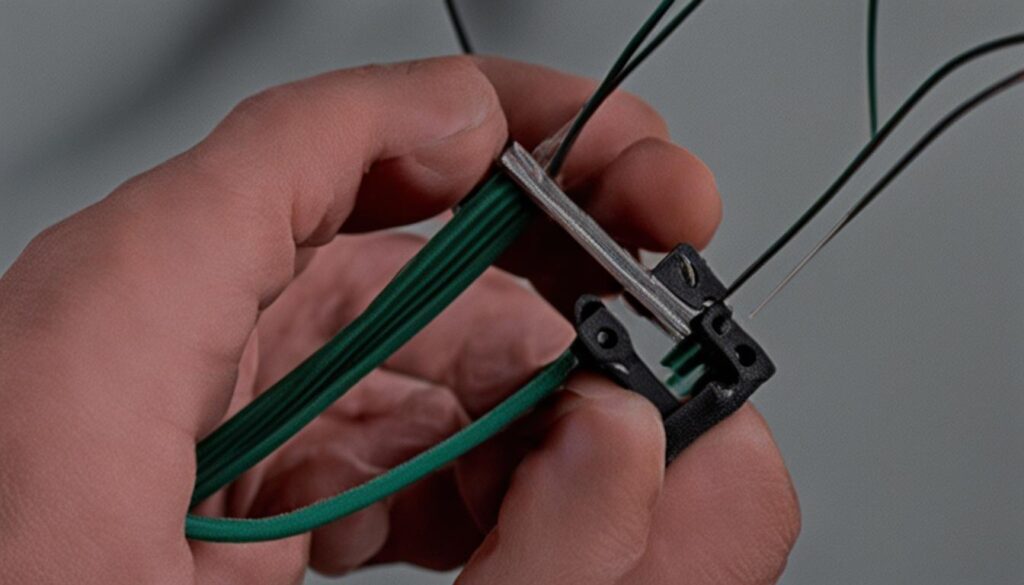Removing a zip tie may seem challenging, but with the right method, it can be done easily. There are a few different ways to remove a zip tie, depending on the type and material of the tie. By following these steps, you’ll be able to remove zip ties efficiently and without any hassle.
How to Remove a Zip Tie
- Unlock the zip tie mechanism by depressing the bar beneath the loose end.
- Refrain from trimming the loose end to reuse the zip tie.
- Use your hands to free yourself from zip tie restraints.
- Choose the method that works best for your specific needs and always prioritize safety.
Method 1: Unlocking the Zip Tie Mechanism
Removing a zip tie can be a quick and simple process if you know the right method. One effective technique is to unlock the zip tie mechanism. To do this, start by locating the small cube-shaped locking mechanism at one end of the tie. Bend the loose end of the tie back to expose the side of the cube with the locking mechanism. Now, using your fingernail or a small tool, depress the bar beneath the loose end. While holding down the bar, pull the loose end back through the cube, and voila! The zip tie will be unlocked and easily removable.
Unlocking the Zip Tie Mechanism Step-by-Step:
To remove a zip tie using the unlocking method:
- Locate the locking mechanism on the zip tie.
- Bend the loose end of the tie back to expose the side of the cube with the locking mechanism.
- Depress the bar beneath the loose end with a fingernail or small tool.
- While holding down the bar, pull the loose end back through the cube.
- The zip tie will be unlocked and can be easily removed.
This method is effective for most types of zip ties and can save you time and effort when removing them. It’s a great trick to have up your sleeve for various situations where zip tie removal is required.
Why Unlocking the Zip Tie Mechanism Works:
The unlocking method works because it disengages the locking mechanism of the zip tie. By depressing the bar and pulling the loose end back through the cube, you release the tension and allow the tie to be removed easily. This technique is particularly useful when you need to remove zip ties without cutting them, preserving their reusability for future projects.
Method 2: Refrain from Trimming
When it comes to removing zip ties, one quick and easy method is to refrain from trimming the loose end. By keeping the excess length of the tie, you can actually reuse it for bundles of the same size or smaller. This can be especially useful if you’re working on a project that requires frequent adjustments or modifications.
However, it’s important to note that with repeated use, the plastic teeth of the zip tie may wear down. So, if you’re planning to reuse the tie, it’s best to avoid using old ones for items that need to be securely fastened. Instead, consider using reusable cable ties for short-term projects where you need to remove and reuse ties frequently.
Refraining from trimming the zip tie not only allows for reusability but also provides flexibility in managing your bundles. Whether it’s organizing cables or securing items together, this method offers a convenient way to quickly remove and adjust zip ties without the need for additional tools or techniques.
Efficiency and Convenience
By choosing to refrain from trimming your zip ties, you can save both time and effort when it comes to removal. With this method, you don’t have to worry about searching for tools or performing intricate maneuvers to unlock the tie. Just loosen the loose end, adjust the bundle, and secure it back in place without any hassle.
Additionally, this method promotes sustainability by reducing waste. Instead of discarding used zip ties after a single use, you can extend their lifespan and minimize your environmental impact. By incorporating this approach into your projects, you can contribute to a more eco-friendly way of working while still enjoying the convenience of using zip ties.
Method 3: Using Your Hands to Free Yourself
If you ever find yourself in a situation where you’re bound by zip ties and need to free yourself, don’t panic. There are a few techniques you can try using just your hands. Start by making your hands as big as possible by squeezing them into fists with the tops facing up. This will give you more space to work with.
Next, relax your hands and turn your palms toward each other. The key is to focus on worming your thumbs out first, as this will make the rest of the process easier. Slowly and gently wiggle your thumbs back and forth, applying pressure in an upward motion. With patience and persistence, you’ll be able to loosen the zip tie enough to free your hands.
Alternatively, if you have a partner with you, you can coordinate with them to use a small tool to help release the tie. A nail or the corner of a credit card can be used to lift the bar inside the locking mechanism, allowing the tie to come undone. It’s important to be cautious and work together to ensure everyone’s safety during the process.
Safety First
When attempting to remove a zip tie using your hands, it’s essential to prioritize safety. Avoid using excessive force or pulling too aggressively, as this can cause injury. Take breaks if needed, and if you’re unable to free yourself, seek assistance from others or contact the authorities for help.
Conclusion
Removing a zip tie doesn’t have to be difficult. When it comes to DIY zip tie removal, there are various methods you can use to unfasten those stubborn ties. Whether you’re looking to remove a zip tie for reusability or free yourself from restraints, these techniques will help you get the job done easily and efficiently.
One method that works for most types of zip ties is unlocking the zip tie mechanism. By locating the small cube at one end of the tie and depressing the bar beneath the loose end, you can pull the tie back through the cube and remove it.
If you want to reuse a zip tie, remember to refrain from trimming the loose end. By keeping the excess length, you can reuse the tie for bundles of the same size or smaller. However, be aware that the plastic teeth may wear down with repeated use, so avoid using old ties for items that require secure fastening.
If you find yourself bound by zip ties and need to free yourself, there are a few techniques you can try using your hands. Squeezing your hands into fists and then relaxing them with palms facing each other can help you wiggle your thumbs out and release the tie. Alternatively, you can coordinate with a partner to use a small tool like a nail or the corner of a credit card to lift the bar inside the locking mechanism and set yourself free.
Remember to always prioritize safety and choose the method that works best for your specific needs. With these tips, you’ll be able to tackle zip tie removal with ease and confidence!
FAQ
How do I unlock the zip tie mechanism to remove it?
To unlock the zip tie mechanism, locate the small cube at one end of the tie, which is the locking mechanism. Bend the loose end of the tie back to expose the side of the cube with the locking mechanism. Use a fingernail or a small tool to depress the bar beneath the loose end. Push down on the bar while pulling the loose end back through the cube, and the tie will be removed.
Can I reuse a zip tie?
Yes, you can reuse a zip tie by avoiding trimming the loose end once it’s in use. By keeping the excess length, you can reuse the tie for bundles of the same size or smaller. However, note that the plastic teeth may wear down with repeated use, so avoid using old ties for items that need to be securely fastened. Consider using reusable cable ties for short-term projects if you need to remove and reuse ties frequently.
How can I free myself from zip ties?
If you find yourself bound by zip ties and need to free yourself, squeeze your hands into fists with the tops facing up to make them as big as possible. Then, relax your hands and turn your palms toward each other. Focus on worming your thumbs out first to make the rest easier. Another method involves coordinating with a partner to use a small tool, such as a nail or the corner of a credit card, to lift the bar inside the locking mechanism and release the tie.


